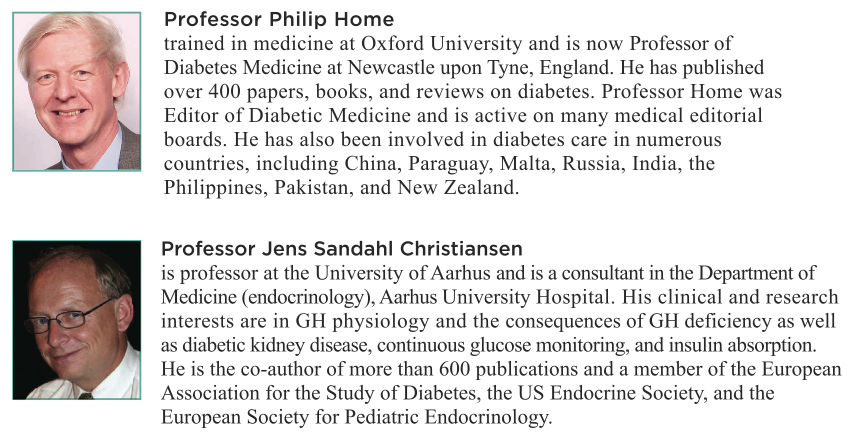Our Discussion with Diabetes Experts Professors Philip Home and Jens Sandahl Christiansen: Provocative Thoughts on Patient-Involvement, Potential Game-Changers, and Where to Spend Ten Billion Dollars
By Adam BrownKelly Close

by Adam Brown, Kelly Close, Alexander Wolf, and Nancy Liu
Twitter summary: @kellyclose + Profs Home + Christiansen discuss solvable problems in #diabetes – more patient focus, $10 billion question, and game-changers!
Short summary: At the recent EASD conference in Vienna, diaTribe founder Kelly Close moderated a panel discussion with diabetes experts Professors Philip Home and Jens Sandahl Christiansen – the focus was “Solvable Problems in Diabetes.” We highlight their thoughts on the need to better empower patients in their diabetes management, future game-changers, and where they’d spend $10 billion.
As discussed in last issue’s Letter from the Editor, The diaTribe Foundation recently hosted an event – “Solvable Problems in Diabetes” – during the European Association for the Study of Diabetes (EASD) Conference in Vienna. The panel discussion, led by diaTribe founder Kelly Close, shared thoughts from two influential diabetes experts: Professor Philip Home, a Professor of Diabetes Medicine at Newcastle University in the UK, and Professor Jens Sandahl Christiansen, a clinical professor in the Department of Endocrinology and Diabetes at Aarhus University in Denmark.
Boy, did we learn a lot! In this diaTribe dialogue, find out what these experts had to say about:
-
How to empower and support patients to improve management
-
Potential game-changers in the future of diabetes
-
What they would do with $10 billion to invest in diabetes
-
Plus, see how they responded in our bonus lightning round!
HARNESSING PATIENT BRAINPOWER AND THE NEED FOR URGENCY
Ms. Close: Thank you so much for joining us, Professors Home and Christiansen – we’re very lucky to be talking with you. First, let’s talk about whether we can we do more to involve patients in diabetes care.
Prof. Christiansen: If we don’t involve the patient, we’re lost. Looking at our systems, we can see that they don’t work. Our systems look at adherence to procedures but not outcomes.
Prof. Home: Let me ask something: What is the role of the person with diabetes? We’ve had initiatives regarding what care to expect in terms of getting hands and feet checked, that if your A1c is above this level, you should be on double therapy. For some reason, it hasn’t worked. Do they want to be empowered? People want to drive their own healthcare. This is the idea behind the self-monitoring CGM arena. To what extent, can we use that huge resource – their brain – to actually improve care?
Ms. Close: Some of these things might be starting to change. I think that we need to start increasing the urgency with patients and really pushing on the personal responsibility [Editor’s note: She knows that is true for her!]. But until society actually sees this as an urgent problem, I don’t know if the patient actually knows. They don’t get enough time with their healthcare providers and some don’t have access to them at all. Many of them have so much more basic problems associated with socioeconomic status, their shortage of food, and other factors.
Prof. Home: I agree. What can people do with the data that’s already available without having access to a health care provider? Some companies are involved, like Abbott and companies involved with CGM, in making CGM more accessible to people with diabetes and professionals. I see this process as a difficult one; after all, we’ve been working on this since 1987 and we’ve been relatively unsuccessful for reasons I don’t know. But surely, it’s the way to go to use that resource.
Ms. Close: Absolutely, I think that many researchers have been ambitious about having to do this. And I think that there’s a lot that can be said about the data, to make it more understandable for patients and providers. It’s also interesting to see how not only doctors work with this, but also other types of healthcare providers.
FUTURE GAME-CHANGERS IN DIABETES
Ms. Close: Next! What are the next big game-changers in diabetes care?
Prof. Christiansen: Let’s bite the bullet. The most effective medications we have carry an implied risk of hypoglycemia. As long as this is the case, and hypoglycemia is the greatest barrier to perfect management, we can do a lot of other things. We need to offer all patients on these agents the opportunity to monitor, maybe not 100 times a day, but certainly when it’s needed. The technology is just a finger prick, but innovation makes it easier to report results for more people.
Ms. Close: It’s been really exciting from the patient perspective to see new therapies come on the market. When incretins came on in 2005, we finally had some therapies that didn’t cause weight gain and hypoglycemia. I’m really happy that there were the funds to invest in that development all those years ago. I’m not sure if today, we’re still in the same environment. You know, we were sad to see Bristol-Myers Squibb and Genentech leave diabetes altogether and it’s because they just don’t see incentives to stay in the business. I’m glad to see that these therapies exist because they give more options and lead to better access, but I want to make sure that there’s an environment out there where there are funds that are being invested to help diabetes. This brings up the question of whether governments are going to invest in these areas or if they are too short-term thinking? Who’s going to do this? Sulfonylureas (e.g., glyburide, glipizide, glimepiride) would never be approved today as therapy.
Prof. Home: Perhaps we’re thinking about what a government is going to do and why. Governments do things because they are driven in particular directions. It comes back to the diabetes community. The lobbying and parliamentary groups are quite important and effective. Governments are never going to provide the funding for technology development. The research budget is going more toward fundamental science, so the technological developments are going to have to come from a commercial approach. I’m a supporter of that. But we’ve seen the difficulty with that approach.
Ms. Close: I would love to see more major foundations in the world go in the direction of the Helmsley Charitable Trust. We must show them that the return on investment can be very positive. What is it going to take for foundations like the Bill and Melinda Gates Foundation to be investing in diabetes? I’m really excited to think with stakeholders about what pilots we could take to those foundations.
WHAT WOULD YOU DO WITH TEN BILLION DOLLARS?
Ms. Close: So, what would you do if you had $10 billion to invest in diabetes? The US just spent 20 times that on diabetes in this past year alone.
Prof. Home: I’d go for the two key fundamentals. One is our excess calorie intake. The other is insulin, because it’s not insulin itself that causes hypoglycemia; it’s the way we give it and the lack of feedback control. If we could develop glucose-sensitive insulin and feedback closed-loop systems, that would be great. Glucose-sensitive insulins would be one of the biggest things to affect hypoglycemia.
Prof. Christiansen: It’s still an enigma to me in type 1 and type 2, that there are a number of patients we call non-responders, and there are patients who never get complications despite the fact that they aren’t well controlled by all measures. There have been huge studies from industry with new insulins and other drugs that show a typical response to treatment in one big group, but there are a significant number of so-called non-responders, and we don’t understand why. In the future, we need to better understand that it’s not only type 1 and type 2, and that it’s not only about hypoglycemia and dyslipidemia. There are things there that we don’t understand.
LIGHTNING ROUND
Ms. Close: Soda tax: yes or no?
Prof. Home: Yes.
Prof. Christiansen: Well, then I’d say no. [Laughter]
Ms. Close: Biggest patient barrier: hypoglycemia or weight gain?
Prof. Christiansen: Hypoglycemia.
Prof. Home: The answer is not weight, by the way; it’s calories. For type 2 patients, it’s calories. For type 1 patients, it’s hypoglycemia.
Ms. Close: Which diabetes therapy is more likely to reduce the risk of cardiovascular disease – GLP-1 receptor agonists or SGLT-2 inhibitors?
Prof. Christiansen: GLP-1.
Prof. Home: GLP-1.
Ms. Close: Will we look back at cardiovascular outcome trials (CVOTs) as helpful or not?
Prof. Christiansen: No.
Prof. Home: No, bury them.
Ms. Close: Which pill formulations of injectable drugs are most promising – oral GLP-1 or oral insulin?
Prof. Christiansen: The combinations?
Prof. Home: The problem is not insulin. It’s feedback. So oral GLP-1.
Ms. Close: Who should patient advocates focus on: payers or regulatory agencies?
Prof. Christiansen: I think regulators are authorities that have some kind of common sense. I think you need to work with payers because at the end of the day, they decide in America.
Prof. Home: It’s two different areas in product development. Payers in one corner; regulators in the other. Regulators are still more important.

What diabetes game-changer do you want to see in the future? Where would you invest 10 billion dollars? Write us your opinion and let us know!







